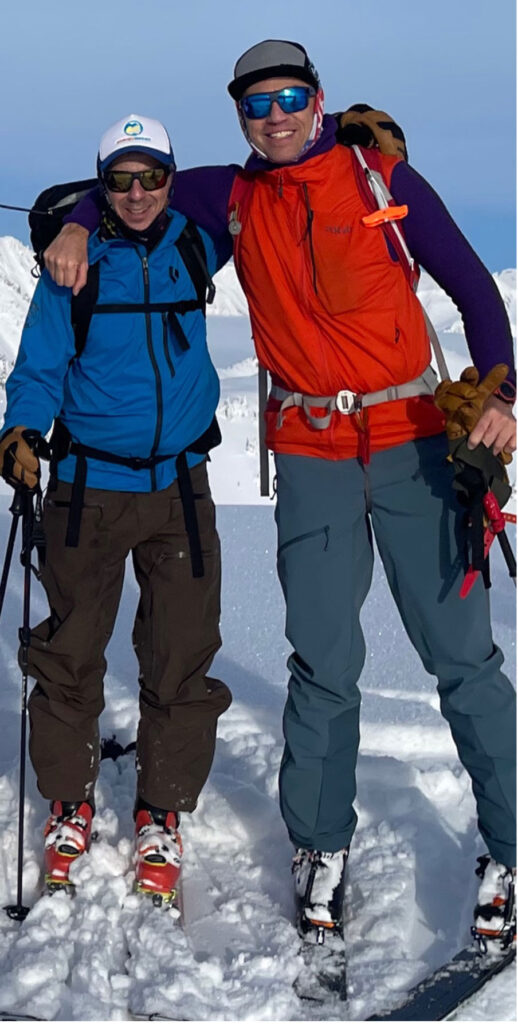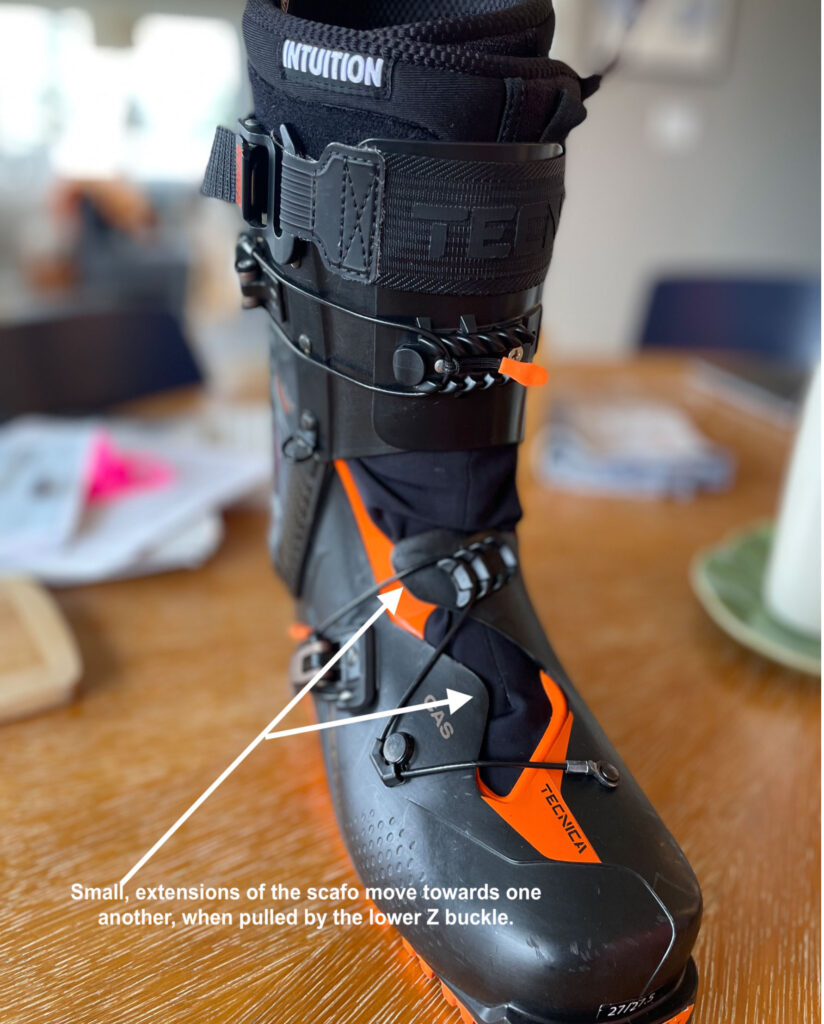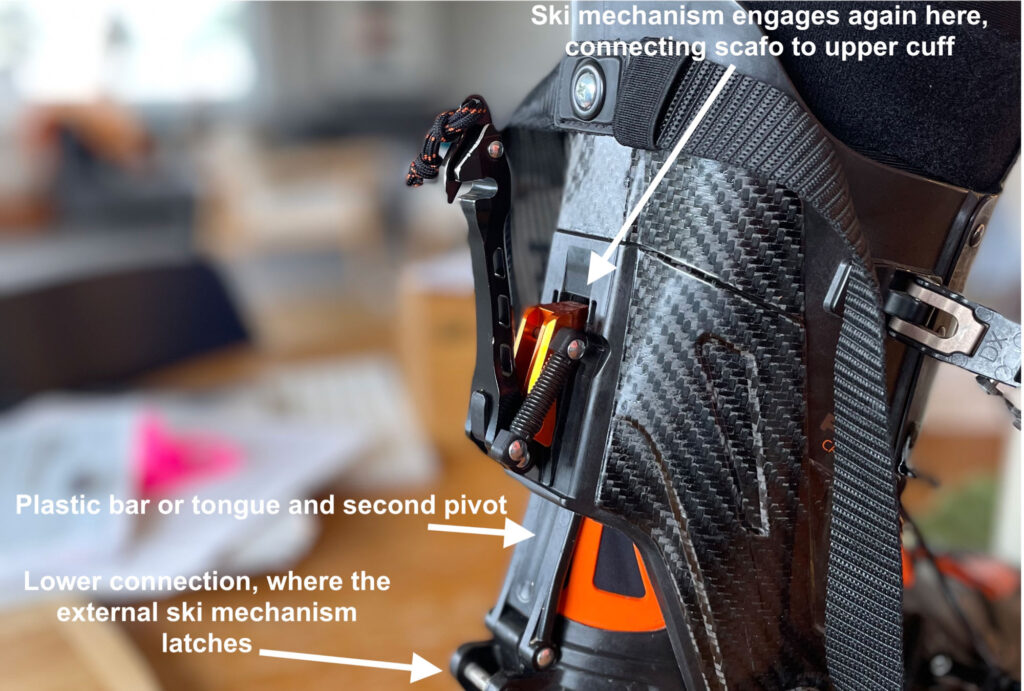Powder Cloud Likes: Tecnica Zero G Peak Carbon
If your touring partner called the day before you were scheduled to depart on a week-long hut trip to Sunrise Lodge in Canada and said, “I’m bringing my new ski boots that I haven’t tried or gotten molded,” you would rightly roll your eyes. What sort of goon brings a totally untested boot to Canada, with a week of touring on the line?
That would be me.
My pair of Tecnica’s new sub-1,000 g Zero G Peak Carbon arrived in the mail the day before I left. And because it’s better to be lucky than smart, I could not have picked a better boot to be stupid in. My quick take? Wow and some more wow, with a dash of fantastic and one complaint.
I notched seven days in the Peak in the Northern lands and full disclosure, the snow gods were in a good mood, so I skied fluff the entire time. I did have to cross tracks at least twice during the week, though…. (Oh, the suffering!) But, to give the boot a fair test, I skied the Peak several more times upon returning to my home state of Washington on everything from breakable crust to skied-off doomsday ice.
The Fit
The Tecnica website calls the last a “medium” fit (99 mm on the instep). My foot is low-medium volume and not particularly tricky to fit in most boots.
I ordered a slightly roomy size 27/27.5 Peak because I typically put an Intuition Wrap liner in my boots, which has a higher volume than the stock, which in this case is a CAS Light Liner (217 g). The CAS stands for “custom adaptive shape,” and it’s noticeably thinner than an Intuition, more akin to a Palau. It also has a waterproof-breathable membrane and a Recco reflector in there somewhere.
With the stock liner, the Peak felt a tad big, so I dropped in one of my older Intuition Wraps and my Sidas Custom Winter Pro Mesh footbeds, which also have a higher volume and weight than the stock, and, bam, they felt great. The boot reminded me of the original Dynafit TLT 5—snug from the heel to the instep, but the toe box on the Peak is noticeably more spacious than previous TLT models.
“Woah,” I thought to myself, “I might take this boot to Canada.”
Of course, some of this is luck of the draw with my foot shape, and my Intuition had been molded to my foot. Whatever the alchemy, it was the best out-of-the-box fit I’ve ever had in a ski boot.
Boot Construction
The lower (scafo) is a carbon-infused polyether (a material related to polyurethane). On the upper, there is an actual carbon-fiber cuff. A Z buckle tensions the lower boot, while a single upper buckle closes the cuff. Above that, Tecnica improved the nylon power strap from their Pro Tour (the old one tended to slip) with a cam buckle and strap that locks securely.
The shell is a hybrid: It utilizes the power transmission of an overlap design in the upper and lower and sneaks in the lightweight, walking prowess of a soft, gaitered boot (like Scarpa’s F1 LT) on the front. The gaiter is waterproof, near as I can tell, but spring in the Northwest will be the test of it.
The scafo, once buckled, almost overlaps—the cable guides on the lower buckle pull toward one another and two small tongues nearly touch. The upper employs a true overlap design, which delivers a surprisingly stout feeling. I hesitate to assign a number to the flex, but I’ll call it 110ish.
The ski/walk locking mechanism is behind the carbon cuff, vertically along the achilles. It’s a spring-loaded beam that looks fairly traditional, but if you investigate a bit, it’s pretty ingenious. The beam folds down into ski mode and hooks onto a horizontal bar affixed to the scafo—nothing new there. Then, the Peak builds in some extra security, rigidity, and control in its second connection point, a rigid plastic bar that runs vertically up the cuff of the boot. Tecnica calls this the T-Hike construction. At the top of this bar is a small notch where the ski mechanism locks when engaged in ski mode, so the upper cuff and scafo connect in two places, rather than just one.
Apparently, the Peak also has a carbon reinforcement in the sole to give it a more rigid platform. I’ll buy it —the Peak has none of the torsional flex I’ve felt in lightweight boots and feels more like its heavier cousin, the Zero G Pro Tour, in terms of power transfer and rigidity.
Inside you’ll find a boot board and a ramp angle of 3 degrees. I didn’t mess with any of this, but it is adjustable. There’s also an add-on rear spoiler that will push you forward two degrees from the standard 13-degree forward lean.
After a dozen days of mid-winter touring (I haven’t booted with crampons yet), all the hardware—buckles, walk mechanism, power strap—seems durable, but to be honest, I haven’t hammered these things yet. Spring skimo, in a place like Colorado or the Alps, could be an issue with some of the lightweight materials, though the buckles can lay flat in walk mode, reducing the chance of sheering one off. When post-holing, I’d be a bit concerned about damaging the walk mechanism, but any boot is going to have protruding bits, so it’s just the risk we run.
The tech inserts are Dynafit Quick Step-In Low Tech, so they feature the little channel that guides your toe pins into the dimples. Vibram rubber on the sole will be good for summit scrambles. The shell material, for those of you who need to punch or grind, has little dimples in the typical areas that facilitate heat-molding.
Liner Considerations
Tecnica has put a lot of effort into their liners in recent years, and for most folks, the stock liner will work just fine. (If I were sticking with the stock CAS Light liner, I’d probably size down.) But for those who prefer to drop in an Intuition liner, it may require some strategy.
For starters, stuffing an Intuition into the Peak means more volume in the waterproof gaiter. If I have one gripe about the Peak (albeit self-inflicted), it’s that the boot is difficult to get off at the end of the day. I have probably wedged too much liner in the boot, so consider this pilot error.
After Canada, I replaced the older Intuition Wrap liner with a nearly new Tour Wrap (203 g). I put a 4 mm foam spacer in to accommodate for the lack of foam in the new Tour Wrap sole, then my Sidas heat-molded footbed. The fit is primo.
The Up
Having been in a TLT 6 for much of my skiing over the past several seasons, the Peak immediately impressed me for its walkability. Its range of motion (they call it 70 degrees) exceeds the older Dynafit’s. (I haven’t toured in the TLT 8 or X, so I can’t compare them.) In the little time I’ve spent in an F1 LT, I’d call the uphill range of motion comparable.
The Tour Wrap has quite a bit more material in the front of the foot, which decreases a bit of the walkability when compared to the stock CAS Light liner. If you run warm and the sizing works, the CAS Light does feel better on the uphill (I skinned a day at the resort with them to see). But when it comes to the downhill, the Intuition liner improves the experience, for me, so that’s just a personal trade-off I’m willing to make.
The Down
And now, dear reader, I shall gush. Even a dullard like me could design a boot for the uphill, because it seems to me all you need for that is a warm shoe. But for the down, well, that’s where things get complicated. Any improvement for the up has the potential to wreck the down—and there’s no point in evaluating one without considering the other. Call it a yin-yang theory of skiing footwear.
The Peak, in short, does everything well on the down. When paired with an appropriate ski (sub 1,500 g and 105 mm underfoot or less seems like the sweet spot to me), the Peak is fantastic. Soft snow? The Peak will happily drive a bigger ski on a pow day. Rain-soaked-then-refrozen piste on Snoqualmie’s “Summit West” resort? The Peak still initiated nice edge-bite on my Dynastar 99’s for medium-radius turns.
The shape and material in the boot accounts for much of the ski performance. The Peak’s overlap construction in front of the shin provides support without feeling “dead” or ramming full-stop into its range of motion (a common problem with carbon). “Progressive flex” is the buzz phrase in every boot description ever written, but in this case, it actually fits.
I loved the TLT 5 and 6 carbon models for their lateral stability and rigidity, and the Peak delivers equivalently solid torsional control and power. The scafo does feel stiffer on the Tecnica, however, in part because of the carbon reinforced sole. (Tecnica also makes the Zero G Peak, a similar boot save the carbon cuff, which could be a softer option for split-boarders riding a hard boot.)
The ski mechanism does its job—no slop and, together with the rigidity of the cuff, it gives the Peak a solid, predictable feel. The walk-ski mechanism appears to be field-serviceable, with two small bolts on the inside of the cuff, but the buckles are most likely not because they’re riveted into the shell rather than secured with nuts and bolts.
One minor quibble: The Peak doesn’t transition as fast as a TLT or F1 LT, but I’m OK with that. The older I get, the more I realize that rushing through transitions not only stresses out my clients, but it also speeds up decisions that might be better made in a slower state. So if it takes a few more seconds to dial my boots in, well, I guess it helps with all the mindfulness stuff everyone’s going on about.
But before I start waving crystals and offering life-coaching on men’s retreats in Costa Rica, let’s wrap this thing up.
The Debrief
For human-powered touring, ski-mountaineering, softer snow climates, and finesse skiers, I just can’t think of a better boot. (If you’re 200-plus pounds or looking to really charge on hard snow or with skis fatter than 110 mm at the waist, you may overpower it.) It has the best downhill performance of any lightweight boot I’ve used, and the fit seems to be easy for most skiers. It’s warm, versatile, comfortable, and powerful. In short, the Peak Carbon will be my adventure partner for as long as it lasts.

Rob Coppolillo lives in Seattle with his family. He’s the author of three books and he guides ski-touring throughout North America and Europe. Check out his trips at vettamountainguides.com and follow his adventures with guests at @vettamtnguides or @sailboatskisvalbard.




